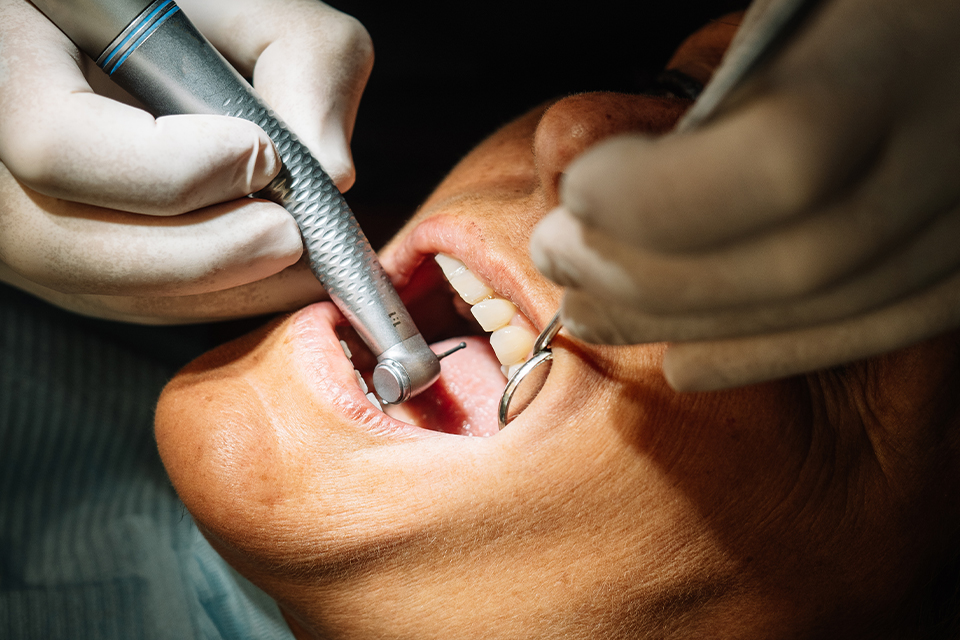Tooth scaling is a form of deep cleaning that dentists do to remove plaque and tartar from the tooth surfaces both above and below the gumline. It is usually used when there is a build up of plaque and tartar and, particularly, if a patient is showing signs of gum disease like gingivitis or periodontitis. In cases of early to moderate gum disease, tooth scaling is often used in conjunction with root planing as an effective treatment. In this article we will discuss what tooth scaling is, types of scaling, when it is used, how it feels, how long tooth scaling takes, and how often to get tooth scaling.
What is Tooth Scaling?
When dentists perform tooth scaling, they are removing deposits of plaque and tartar from the teeth. It is usually performed on a patient with signs of gum disease where the plaque buildup has caused the soft tissue around the teeth to become inflamed and swollen. This non surgical procedure is performed in the dental clinic and typically takes between 30 and 60 minutes depending on the level of plaque buildup. The dentist or periodontist uses specialised tools like manual tools or ultrasonic devices to remove the plaque and tartar on the tooth surface, between the teeth, and above and below the gumline. It is a safe and effective treatment for removing and preventing gum disease.

Is Tooth Scaling the Same as Tooth Cleaning?
Tooth scaling and tooth cleaning are both methods used by dental professionals to clean teeth. However, tooth scaling is part of a much deeper cleaning procedure compared to tooth cleaning. Dentists perform tooth cleaning as part of a regular checkup to prevent gum disease, while tooth scaling is used when gum disease is present. Both methods are used to remove any plaque or tartar but tooth cleaning removes it from the surface of the teeth, while tooth scaling removes it from above and below the gumline, the primary cause of gum disease.
A dentist performs standard tooth cleaning by removing plaque or tartar with either manual tools or ultrasonic devices. The procedure is then completed with tooth polishing and possibly fluoride treatment. Tooth cleaning is recommended every 6 months as part of an oral health strategy to prevent gum disease and cavities.
Tooth scaling, on the other hand, is part of a broader dental cleaning treatment that dentists or periodontists perform to remove gum disease. Using manual tools or ultrasonic devices, scaling involves removing deposits of plaque and tartar that have built up on the tooth, gumline and below the surface of the gums. A dentist or periodontist will choose this more intense procedure if extreme plaque build up is observed or the patient has signs of gum disease like swollen or bleeding gums, bad breath or loose teeth. Usually tooth scaling should be done every 6 months, however in severe cases of periodontitis or gingivitis, sometimes 3 to 4 month treatments are necessary.

Types of Tooth Scaling
Scaling is performed by dentists using handheld instruments to remove plaque and tartar from tooth surfaces and below the gumline. There are two types of tooth scaling, either manual or using an ultrasonic device. Both methods can be used regardless of the patient’s age or condition and often the two methods are used together.
- Manual: Manual scaling is when a dentist uses a handle instrument like a dental scaler or curette to remove the plaque and tartar from the teeth and gums. Scalers are a metal instrument with a triangular or pointed blade used to remove plaque and tartar from the tooth surface above the gumline. Curettes have a round, spoon-like shape with a semi circular blade that provides access to the tooth surface, above and below the gumline. Curettes can also be used for root planing.
- Ultrasonic: Dental professionals also use ultrasonic devices to remove plaque and tartar through a water spray and high frequency vibrations. They blast away the deposit of plaque and tartar from tooth surfaces, above and below the gum line. The two main types of ultrasonic devices are magnetostrictive and piezoelectric, both using the principle of ultrasonic vibration. The vibrations are transmitted to the scaler tip where they make contact with the tooth surface and break apart the plaque and tartar. Magnetostrictive scalers use a stack of metal strips that vibrate when exposed to an alternative metal field, while piezoelectric scalers use ceramic crystals that expand and contract when electricity is applied.
What Happens During Tooth Scaling?
Before a tooth scaling procedure the dentist or periodontist will examine the teeth and gumline for signs of bleeding, receding gums, loose teeth, plaque and tartar buildup. The dentist will examine any X-rays and discuss the procedure with the patient, including any concerns of issues of discomfort. When the procedure takes place, the general process includes:
- Local anaesthesia: The area will be numbed with a local anaesthetic to minimise any discomfort from the procedure. The only sensation a patient should feel with anaesthesia is a scraping feeling without pain.
- Tooth scaling: The plaque and tartar is removed from the surface of the teeth, between the teeth, above and below the gumline, focusing on areas with significant plaque accumulation or signs of gum disease. Using manual or ultrasonic tools, or a combination of both, the dentist will aim to remove all of the plaque and tartar.
- Planing roots: While root planing is not always essential after tooth scaling, it is often done in more extreme cases of gum disease and plaque buildup. Root planing involves using an instrument specifically on the roots. Either using a manual or ultrasonic instrument, the dentist smooths the roots below the gumline, removing plaque and tartar buildup and bacterial toxins, and encouraging the gums to reattach to the teeth.
- Polishing: Teeth are usually polished after both tooth scaling or tooth scaling and root planing. The dentist uses the combination of a rubber cup, polishing paste and air powered device to remove severe stains and any leftover debris.
- Antibiotics: Depending on the severity of the gum disease, a dentist may prescribe oral antibiotics to help control infection.
- Follow up appointments: The dentist will probably recommend follow up appointments to monitor the success of the tooth scaling treatment and protect against further dental issues.
How Long Does Tooth Scaling Take?
The process of tooth scaling typically takes between 30 and 60 minutes, depending on the severity of the plaque and tartar buildup. More plaque and tartar will take longer to remove. If the tooth scaling includes root planing, the procedure can take up to two hours. Depending on the level of gum disease, sometimes deeper cleaning including tooth scaling and root planing can be done over two sessions.
The main factors impacting how long tooth scaling will take include the amount of plaque and tartar buildup, the type of cleaning, the individual’s oral health, and the dental professional’s level of experience.
Does Tooth Scaling Hurt?
While tooth scaling might be slightly uncomfortable, it does not usually cause pain. Dentists use local anaesthesia or other pain relief measures to ensure the procedure is as comfortable as possible. Sometimes patients may experience slight stinging of the gums or a scratching sensation if there is significant plaque and tartar buildup. After the tooth scaling procedure,there may be some gum or jaw soreness, gum bleeding or tooth sensitivity but it is usually mild and temporary.
Benefits and Risks of Tooth Scaling
Benefits
Teeth scaling has significant benefits for maintaining oral health and preventing more serious dental issues occurring. The benefits of tooth scaling include:
- Remove plaque or tartar: The main benefit of tooth scaling is the removal of plaque or tartar that causes gum disease and infection.
- Get rid of gum disease: Scaling reduces plaque and tartar buildup on the teeth and gums that causes gum disease. With no plaque and tartar on the gums or teeth, there is no gum inflammation, bleeding, or infection of the gums.
- Getting rid of bad breath: Gum disease causes bad breath because the gums pull away from the teeth and fill with odour causing bacteria around the tooth and gums. The bacteria is removed when the plaque and tartar are removed during tooth scaling.
- Prevent tooth decay: Tooth scaling removes food and bacteria deposits from the gums and teeth which can lead to tooth decay and cavities.
- Prevent tooth loss and gum recession: Tooth scaling helps prevent tooth loss and gum recession that is the result of gum disease. Scaling helps the gums remain firmly connected to the teeth and helps reverse receding gums when gum disease has occurred.
Risks
While there are some risks when it comes to tooth scaling, the procedure is essential for preventing or curing gum disease and associated side effects. Some of the risks of tooth scaling include:
- Bleeding: Sometimes gums will bleed after tooth scaling, particularly if the gum disease is advanced. This will be a temporary side effect as tooth scaling actually removes gum disease and the bleeding that has occurred previously.
- Gum swelling: For a day or two after the procedure, gums may swell as a reaction to the tartar being scraped off. Gargling with warm salty water can help reduce this temporary inflammation.
- Teeth sensitivity: Sometimes after tooth scaling, teeth may become sensitive for a couple of days. This is because the removal of the plaque and tartar from the teeth and gumline possibly exposed a tender part of the tooth or the roots in cases of extreme gum disease. This sensitivity will pass after a few days.
When To See A Dentist For Tooth Scaling
During a routine dental examination, a dentist will be able to see if you have any signs of gum disease and may recommend tooth scaling. Apart from that, you should see a dentist for potential tooth scaling if you experience any of the following.
- Bad breath: Bad breath or halitosis is linked to poor oral hygiene and can be eliminated with tooth scaling. The procedure reduces plaque and tartar which harbours bacteria and causes bad breath.
- Bleeding gums: If you have bleeding gums, there is a high chance it is caused by gum disease, whether they bleed regularly, occasionally or even after flossing. If you do experience bleeding gums, it is important to consult with a dentist immediately.
- Gum recession: Gum recession can be a serious issue for oral health as it is an indicator of gum disease. Gum recession is when the gum starts pulling away from the tooth and must be addressed by a dentist to avoid any further tooth or gum issues.
Tooth scaling is an important part of dental hygiene but many people don’t fully understand what it is. The procedure removes plaque and tartar buildup and is a more intense form of tooth cleaning as a treatment for gum disease. Whether you need tooth scaling depends on the condition of your teeth and gums. In this article we address all aspects of tooth scaling, what it is, the procedure, if it hurts, and when to see a dentist. For any further questions on tooth scaling or if you experience any of the symptoms mentioned, contact the team at Hawthorn Road Family Dental.





